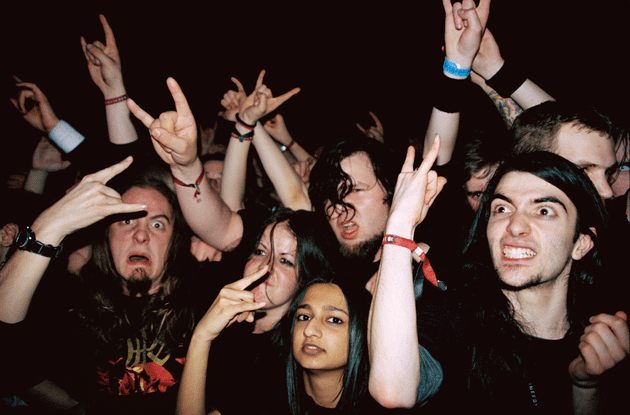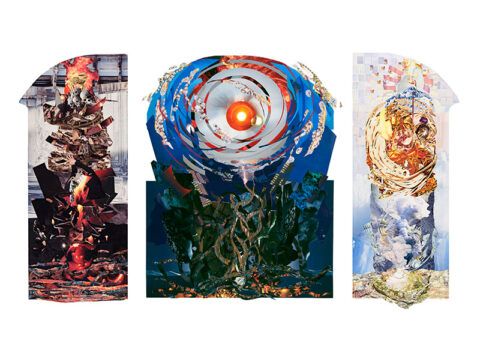My Top 5 Metal Albums and Their Poetic Counterparts
Havoc, and spoil, and ruin be thy gain

The audience at Inferno Festival, Ohio. Photograph by Peter Beste, from his monograph True Norwegian Black Metal, published by Vice
Metalheads love lists. Decibel has special issues devoted to the Top 100 Death Metal Albums of All Time and the Top 100 Greatest Metal Albums of the Decade. The popular site Metal Injection runs lists like Top 10 Worst Crimes Committed by Black Metal Musicians. In connection with my article linking the genre with poetry in this month’s issue of Harper’s Magazine, it is therefore my metallic duty to compile a list of My Top 5 Metal Albums and Their Poetic Counterparts.
I’ve limited myself to records made after 1980, because otherwise I’d just list my favorite AC/DC and Black Sabbath records in alphabetical order. Also, this way I don’t have to deal with the question of whether, say, Thin Lizzy and UFO count as metal.
Which reminds me: the most annoying aspect of metal fandom is its inane insistence on policing genre boundaries. Every time I write about metal someone informs me that “Zeppelin isn’t metal” or that metal is entirely distinct from rock and roll. At the (often terrific) metal website Invisible Oranges, writer Cosmo Lee complained of Decibel’s decade list that “at least 15% of the list isn’t metal” (he also sniffed at the magazine’s profligacy with the term “hardcore,” which he feels should be reserved for “true hardcore,” ahem). This is like bitching that Taylor Swift isn’t country. Genres are fluid categories — useful as long as you don’t confuse them with dictionary definitions or algebraic equations. Is The Tempest a romance or a comedy or something else entirely? How punk is London Calling? Is this Lydia Davis thing a poem or a story? The answer is always: it depends.
1. Death, The Sound of Perseverance (Nuclear Blast, 1998). In the state with the prettiest name, the late Chuck Schuldiner basically invented death metal. This is my favorite Death record, although Human is a close second. It’s proggy, sinister, majestic. The death-obsessed Thomas Lovell Beddoes comes to mind. But the album’s on-a-dime swaps — rocketing melodies for eerie minor-key riffs for industrial brutality — call for a counterpart with weird, intricate metrics. I suggest the poems of the Jesuit priest Gerard Manley Hopkins (Schuldiner found Satanism silly, and he loved animals).
2. Slayer, Reign in Blood (Def Jam, 1986). It might be a coincidence that so many fans use the words “chaos” and “pandemonium” to describe the contradictory turmoil of this speed-metal landmark — fast, tight, in and out of control. But Chaos is Milton’s word for the “womb of Nature” containing the “dark materials” from which God creates the universe, and Pandemonium his name for the “High Capital / Of Satan and his peers.” And Milton, as Blake knew, was “of the Devil’s party without knowing it.” So Paradise Lost is the poetic counterpart of Reign in Blood (whose comic-horrific cover depicts the goatish Evil One borne across a lake of fire and blood). “Go and speed,” a personified Chaos tells Satan in the poem; “Havoc, and spoil, and ruin, are my gain.”
3. Converge, Axe to Fall (Epitaph, 2009). Converge is my favorite band. Jane Doe is, by critical fiat, their stone-cold masterpiece, but this later slab of metal punk is the one I love most. The ferocity of Jacob Bannon’s screams and Kurt Ballou’s bunker-busting guitars suggest the Flanders-Field carnage and machine-gun rhythms of Christopher Logue’s new-wave version of the Iliad’s battle scenes, All Day Permanent Red: “The noise they make while fighting is so loud / That what you see is like a silent film.”
4. Guns N’ Roses, Appetite for Destruction (Geffen, 1987). Yes, there’s filler, but this record’s had its hooks — and what hooks — in me since I first saw the video for “Sweet Child o’ Mine” in high school. Someone pointed out to me that there are more allusions to GN’R in my first book of poems, Alien vs. Predator, than to any other band or author. Therefore my own work is the poetic counterpart of Appetite for Destruction. If that’s too obnoxious, well, so are GN’R. But please also see, for destruction and appetite, Chelsey Minnis’s Poemland and Ooga-Booga by Frederick Seidel.
5. Mastodon, Remission (Relapse, 2002). Riffage. Huge, mud-caked barn doors of riffage. Aluminum siding of riffage slicing through trees of riffage in a hurricane of riffage. The American mastodon (the name means “nipple tooth,” which would also be a good name for a metal band) weighed around five tons, which is exactly how much the Atlanta band’s debut record weighs. But there’s a progressive complexity here too — Bill Kelliher (guitars) and Brann Dailor (drums) trample forests, then carefully diagram each leaf. Their fellow Atlantan James Dickey comes to mind, especially in the whiplash backwoods homily “May Day Sermon”:
Ah, children,
There is now something else to hear: there is now this madness of engine
Noise in the bushes past reason ungodly squealing reverting
Like a hog turned loose in the woods . . .
And, for good measure, five more favorite records (come up with your own poetic equivalents at home!): Iron Maiden, The Number of the Beast; Carcass, Necroticism: Descanting the Insalubrious; Pig Destroyer, Phantom Limb; Dissection, Storm of the Light’s Bane; Manilla Road, Crystal Logic.









































































































